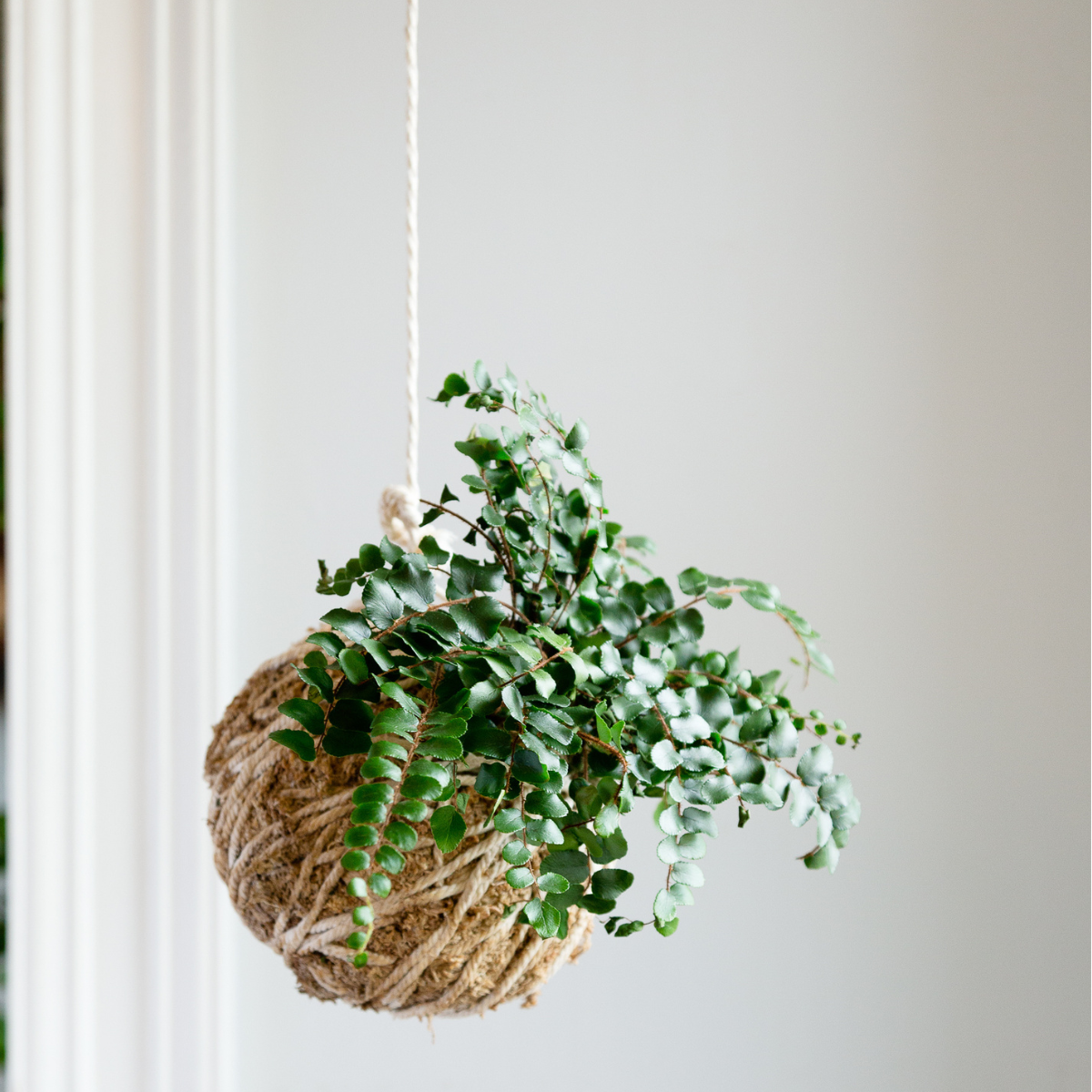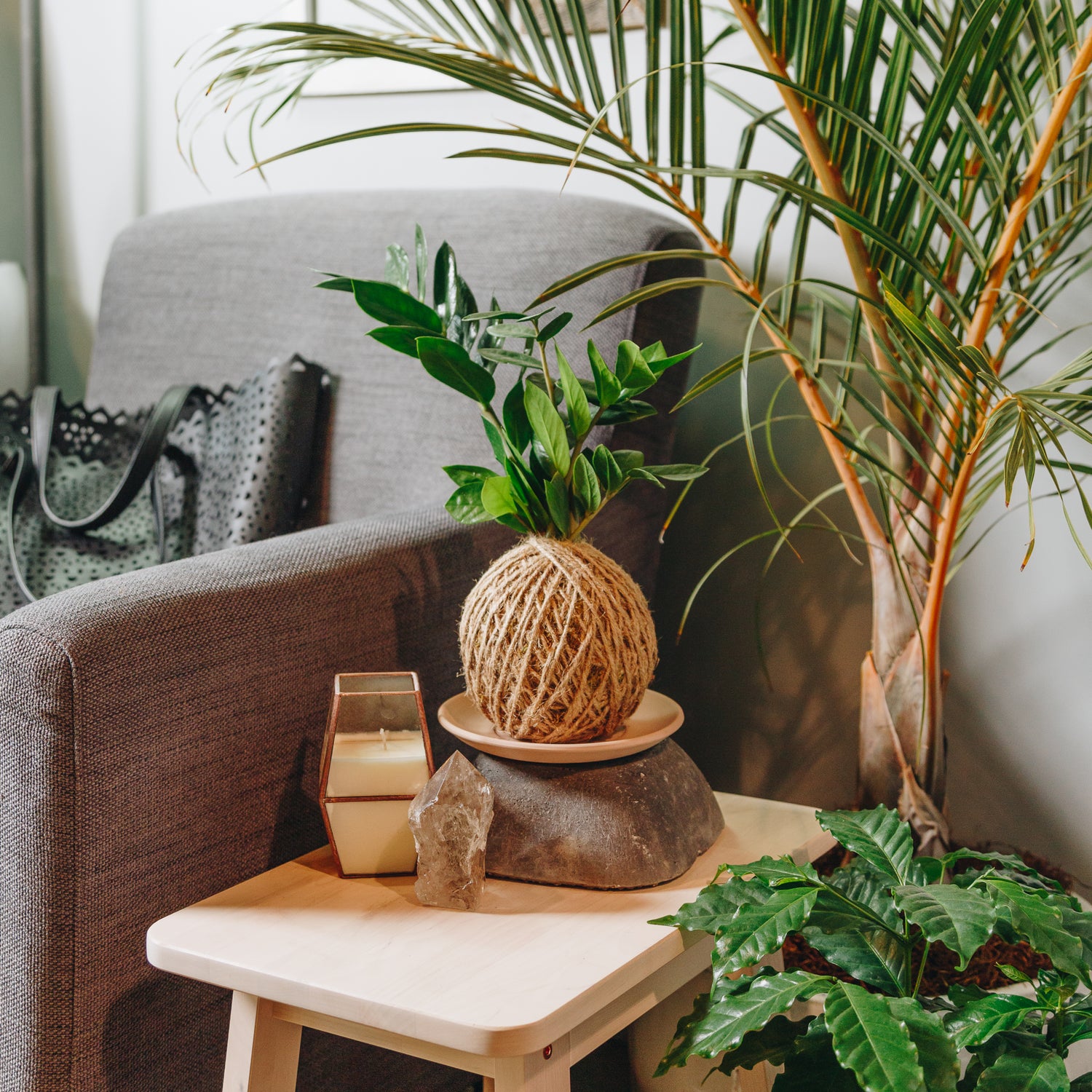
What is Kokedama? The basics of what they are and how you care for them
Kokedama, which translates to "moss ball," is a centuries-old practice that transforms plants into living art, suspended within a sphere of moss and twine. The result is a captivating fusion of nature's elegance and human creativity, making kokedama a unique and eye-catching addition to any living space.
But what exactly is kokedama, and how do you care for and display these charming green orbs? In this comprehensive guide, we'll delve into the enchanting world of kokedama, exploring its history, the plants best suited for these mossy creations, and the essential steps to nurture them.

What is a Kokedama?
A Japanese form of Bonsai (the art of miniaturizing plants) where the root ball of a plant is artfully bound in layers of moss and twine. In this vessel plants go through a process called air pruning, where roots will grow to the edges of the sphere, sense the oxygen on the other side of the moss and stop growing in that direction. The result is a safely dwarfed and perfectly spherical root system.
How do you care for a Kokedama?
Caring for a Kokedama is simple! The type of plant you have chosen to bind and the conditions in your space will determine the frequency of care needed but here are some guidelines to get you started.

Watering & Fertilizing
To water, set the Kokedama sphere in a few inches of water and allow the plant soak for 20 - 60 minutes. Remove from water and gently squeeze out the excess moisture. Do not keep your Kokedama sitting in water longer than 24 hours as this may lead to root decay. To fertilize apply nutrients to the water monthly during growing seasons. We recommend using the bacterial inoculant fertilizer.

When to Water Your Kokedama
The frequency of watering will depend on your individual plant’s needs. For example Snake Plants prefer the soil to dry fully between each watering, while Boston Fern must be kept damp. To determine how dry the soil inside your Kokedama is feel the moss on the outside of the sphere and hold the sphere in your hands to determine its weight.A fully dry Kokedama will feel very light weight and the moss on the outside will feel dry and slightly crunchy.
Most tropical plants prefer to dry 1/2 - 3/4 of the way out between waterings. In this scenario the Kokedama will feel light in weight but some moisture can be felt through the moss.

Light & Temperature
The light and temperature range your Kokedama require also depend on the needs of the plant chosen. Most indoor plants will prefer a medium to bright indirect light exposure and prefer to be kept at room temperature and away from severe changes in temperature like heating vents and AC units.
Continued Care
Your plants will be able to live happily for many years in your Kokedama. Remember that this is a form of Bonsai, so your plant will likely remain smaller than if housed in a regular planter. After about a year the outermost layer of twine may begin to disintegrate due to repeated exposure to moisture. This is to be expected. Simply add more twine to keep the sphere intact as needed.

What plants can I make a Kokedama from?
While a variety of plants can be used to create kokedama, some are better suited than others due to their growth habits and adaptability to the kokedama environment. Here are some plants commonly used for kokedama:
- Ferns: Ferns are a popular choice for kokedama because they have a natural, graceful appearance that works well with the moss-covered ball. Maidenhair ferns and Boston ferns are often used for kokedama.
- Bonsai Trees: Miniature bonsai trees, such as the Ficus or Juniper, can be adapted for kokedama, and they create a unique and striking presentation.
- Succulents: Certain succulents, like Echeveria, Sedum, or Crassula, can be used for kokedama. They have a distinctive appearance and are low-maintenance.
- Ivy: Ivy plants can be trained to cascade down from the kokedama, creating an elegant hanging garden effect.
- Orchids: Some types of orchids, particularly those with aerial roots, can be incorporated into kokedama designs.
- Herbs: Herbs like rosemary, thyme, or oregano are well-suited for kokedama and can also serve a practical purpose in the kitchen.
- Tropical Plants: Some tropical plants, like philodendrons or pothos, can thrive in kokedama when provided with the right conditions.
- Air Plants (Tillandsia): Air plants don't require soil and can be secured to a kokedama base with string or wire. They are a unique choice for kokedama.
When choosing a plant for your kokedama, consider factors like the plant's growth habits, light requirements, and moisture needs, as well as the size of the kokedama you want to create.

Ways to Display your Kokedama
Displaying your Kokedama:
Traditionally Kokedama are hung in groups from the ceiling but there are many fun and interesting ways to display them.
On a decorative saucer
In a macrame hanger
On a floating shelf
As a centerpiece on your table
Set ontop of a bowl or planter
On a pedestal or other stand
Kokedama is not just a container for your plant; it's an art that connects us with the natural world in a profoundly unique way. By mastering the art of kokedama creation and maintenance, you have the opportunity to transform your home into a haven of greenery, a sanctuary where plants dangle gracefully in harmony with their surroundings.
Remember, kokedama isn't just about the end result—it's about the journey. As you sculpt the moss and carefully nurture your plants, you're engaging in a deeply therapeutic and creative process. These living artworks become a source of pride and satisfaction, serving as conversation starters and focal points in your home.
Ready to make your own?
See our upcoming Kokedama Classes
As always, if you have any questions or need some help we're just a call, text, DM or visit away!
We're here for you for every step of your plant care journey.
Blogs you might like to read

